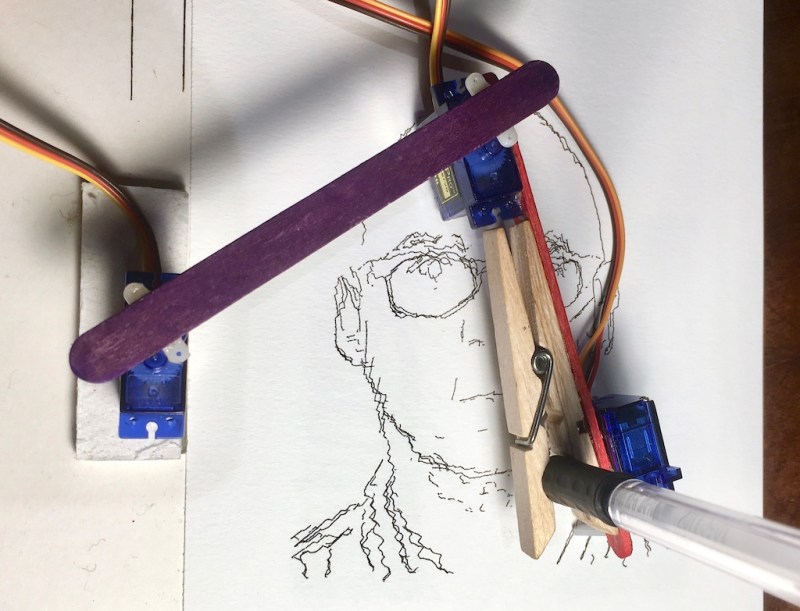The BrachiGraph project consists out of two parts, the hardware design for a servo-driven drawing arm (pen plotter) and software utilities (written in Python) that allow the drawing arm’s servos to be controlled in order to convert a bitmap image into a collection of lines that can be used to draw an image resembling the original, in a variety of styles. All of the software and designs needed to make your own version can be found on the Github page for the project.
Considering an estimated €14 worth of materials for the project, the produced results are nothing short of amazing, even if the principles behind the project go back to the Ancient Greek , of course. The basic hardware is that of a pantograph, which provides the basic clues for how the servos on the plotter arm are being driven.
The main achievement here is definitely that of minimalism, with three dirt-cheap SG-90 microservos along with some bits of wood, a clothes-peg or equivalent, and of course a pen providing a functional plotter that anyone can assemble on a slow Sunday afternoon from random bits lying around the workshop.
















The depth of the documentation on this project is amazing, in addition to how cool the hardware-cost-to-result ratio is.
LOL, that long (and well done write up) but no video in action. Just pure craziness.
I wish there was a video too, but this seems very cool to me. And I have a pi zero and two servos kicking around. At first I was thinking of a third servo, but after looking at the design, I wonder how hard it would be to hack a solenoid in to raise and lower the pencil. It is clever the way they use the servo to lift the pencil, but it also looks like it will try and move the arm sideways as it lifts it up. A solenoid would be capable of lifting it straight up, or so it seems.
“Built with Sphinx using a theme provided by Read the Docs.“
Very interesting! Sets the bar high. It would have been nice to link to a video of things in action.
BTW, isn’t this a SCARA design?
I was thinking the same, Comparing this to a pantograph isn’t really helpfull in how things work.
But if the writer of this hackaday article tries to say that both systems work with a pen on the end of a moving stick, then there is some truth in that.
Regarding the project, very fun project, always cool to see computers “draw” something.
Such plotter was shown already in the early 1980 ties german “MC” Mag. There was shown also the counterpart, a digitizer based on pantograph-geometry, using just 2 potentiometers (variable resistors like volume in old radios) instead of servos (or better stepper-motors) here, so even an VIC-20 or C64 could be used to digitize in 2D, as both machines had dual 8bit A/D-converters in it (normally used for the analog game-controllers (pong-style) called “paddles”. to digitize you had to “copy” over the lines (of the original drawing) holding one button to tell the computer that it is a line, which you are entering. You also could just input all corner-points and let the computer draw the according lines (but only 1st order, streight). I built one that time using wooden construction toolkit from my childhood-days, very rough, but it worked!